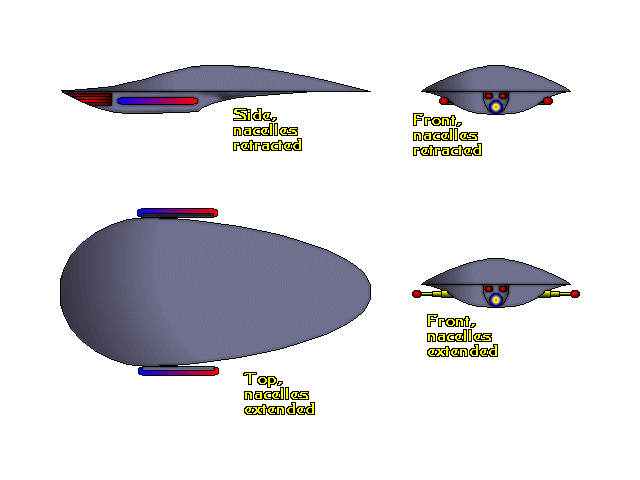 Designer: Robert C. Dunehew E-mail [email protected]
Designer: Robert C. Dunehew E-mail [email protected]
Chevalier class
General Specifications:
Length: 25.9m
Width: 12.5m
Height: 4.1m
Max. Warp: 9.995
Cruise: 9.9
Max. Impulse: 0.9975 lightspeed
Crew: 3
Armaments: Two heavy phaser cannon of classified output coupled to the
phased array; two quantum torpedo launchers (fwd), each capable of firing
four torpedoes.
Type: Space Dominance (Heavy) Fighter
Status:
About Ship: The Chevalier class fighter is a hybrid of new Federation
technology and captured Borg and Dominion technology. The Chevalier is
about half the size of a Danube class runabout. It is a space dominance
fighter with much improved capability over current Starfleet fighters.
From the inception of the battle, the Chevalier will clear out adversary
fighters, disrupt adversary fleets and provide covering fire for friendly
vessels. Its stealth, integrated systems, supercruise and other features
are intended to make it the most potent fighter in the Alpha quadrant.
Features:
-
Stealth: The hull of the Chevalier incorporates a distributed network of
holographic emitters. This provides a chameleon like ability to adjust
hull reflectivity and emissivity, providing a fair imitation of cloaking
without massive power consumption. This makes the Chevalier extremely difficult
to detect and makes a positive weapons lock-on nearly impossible. It does
not, however, confer true cloaking ability. The hull is devoid of markings
that would help an enemy determine weak spots. The holographic hull surface
actively displays desired hull markings such as registry numbers, vessel
name or distinctive insignia.
-
Integrated systems: The hull incorporates a multifunction phased array.
This array is an integrated network of emitters and sensors imbedded directly
within the hull matrix itself. The array includes sensors, phaser emitters,
deflector emitters, and tractor beam emitters. The array can take a significant
amount of damage before performance is significantly diminished. An added
benefit of the phased array is a profound increase in sensor acuity and
range, due to the large size of the array (as big as the hull). The sensor
array provides the ability to precisely target objects 1 meter in diameter
at a distance of just under 4 astronomical units. Dual micro-M/ARA units
provide power, supplemented by a battery of quantum flywheels. The flywheels
store several hours' worth of M/ARA output for combat use, allowing the
vessel's power consumption to temporarily exceed generation capacity by
several orders of magnitude.
-
Supercruise: A combination of hull configuration and variable geometry
permit the Chevalier to cruise at extremely high velocities for extended
periods of time. The additional burst of power provided by the quantum
flywheels allows the Chevalier to increase its velocity to slightly less
than subspace radio speed for about 5 seconds. This permits the vessel
to "bug out" of a bad situation faster than any known potential adversary
can follow. More than 5 seconds at "burst velocity" will destroy the warp
nacelles. This feature is roughly analogous to the "afterburners" or "reheat"
used in late 20th century atmospheric fighters.
-
Other features: The Chevalier is designed to perform a variety of functions
besides direct combat. A two-ship of Chevaliers can establish a subspace
data link, effectively doubling the computer capacity of each ship. This
data link also permits the two-ship to function as a long baseline interferometer,
greatly increasing the range and accuracy of the sensors aboard each vessel.
This feature affords the two-ship superbly accurate targeting information.
This targeting data may be transmitted to other vessels as well, giving
them a "proxy" weapons lock.
The weapons section of the Chevalier is palletized, allowing alternative
mission configurations. One mission configuration is as a planetary survey
vessel (PSV). An extended computer and sensor pallet replaces two phaser
cannon and both torpedo launchers. The PSV pallet allows a two-ship to
survey an enormous volume of space, identifying and classifying all stars,
planets and other objects within this volume.
The Chevalier is as long and wide as, and half the height of
a Danube class runabout. Its crew of three had best be good friends, however,
as the majority of interior volume is occupied by equipment. The internal
volume given over to crew is about 8 cubic meters. This includes the bridge,
sanitary facilities, galley, and bunk area. The bunk area provides space
for two crew members to sit or one crew member to recline. The Chevalier
has no view ports. The bridge view screen is a holographic unit that wraps
around the bridge crew, giving a feeling of open space. Another, smaller
view screen is situated in the bunk area. All potential Chevalier crew
members are screened for claustrophobia before they are assigned.
Return to "Ships Starfleet Never Built."
Return to the Starship Catalogue.


